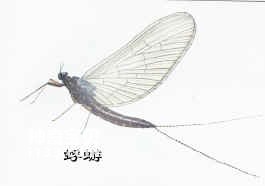The subclass Pterygota has wings or reduced wings. There are no gastropods in the abdomen. Except for the original metamorphosis of the order Ephemera, the rest have incomplete metamorphosis or complete metamorphosis.

[Economic Significance] Adults of mayflies are light in body and elegant in color. They often move around streams and lake beaches. The life span of adult insects is very short, so there is an idiom "live and die in the morning" to describe their short life span. Larvae generally live in fresh water and are excellent feed for fish and various animals. According to the adaptation and requirements of larvae to water areas, it can be used to monitor water type and pollution level. The larvae's elegant body shape and interesting water activities can also add to the fun.
[Identification points] Body length 3-27 mm. The body is slender and very soft. The head is flexible, with large compound eyes and 3 single eyes; the antennae are short and bristly; the mouthparts are degenerated. The wings are membranous, with dense network veins, standing upright on the back when resting; the forewings are large and triangular; the hind wings are small or absent. The tail palps are slender and segmented, and some species have midtail filaments. Adult insects are phototaxis and are often found under lamps. Proto-metamorphosis means that the worm sheds its skin once more in the adult stage. The adult worm before shedding is called a sub-adult.
[Species and Distribution] There are more than 2,250 known species in the world, and about 250 species are currently recorded in my country. Mayflies are mainly distributed in vast areas from the tropics to temperate zones, and are greatly affected by temperature, substrate, water quality, and water flow speed.
The characteristics of this order can be summarized as follows: Ephemera, which live and die, have tentacles like hairs and no mouth; two or three jointed tails, and two or four wings standing upright on the back.
[Biological learning] After the mayfly emerges as an adult, it has to undergo mating between the male and female, and then lays eggs in the water. Each egg is coiled with ciliary substances that extend outward to entangle the eggs in aquatic plants or the bottom of the water. on the gravel. A female mayfly can lay hundreds to thousands of eggs. The eggs go through the embryonic development stage for about half a month in the water at natural temperatures, and hatch out into larvae (the young stages of aquatic insects with incomplete metamorphosis are called larvae). Newly born larvae have not yet developed tracheal gills for breathing in water. During this period, they can only rely on their skin to absorb oxygen from the water. The larvae molt once, and when they reach the second instar, fish-like tracheal gills appear on both sides of the body and they begin normal feeding and swimming activities. A mayfly larvae can live in water for a year and change its "coat" more than 20 times.
The mayfly is inactive during the day, hiding in weeds and behind leaves along the river. Its approximately triangular, transparent and shiny wings are always folded and erected on its back. In the evening, groups fly around the water to mate and lay eggs. Therefore, fish in the water often jump out of the water at night to prey on mayflies flying close to the water. After the male worms mate, they soon end their lives; after the female worms lay eggs and complete the task of passing generations, they also die on the water surface and become bait for fish and frogs.
animal tags: ephemera
We created this article in conjunction with AI technology, then made sure it was fact-checked and edited by a Animals Top editor.